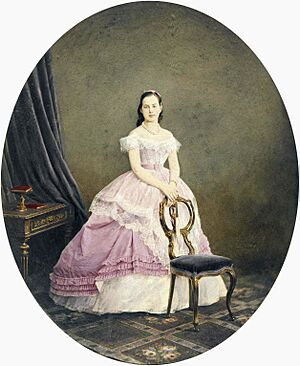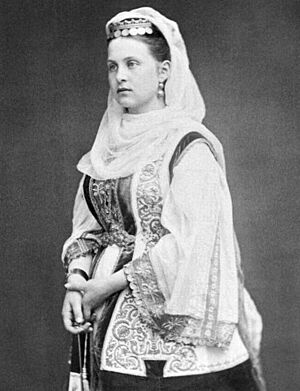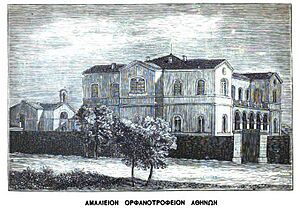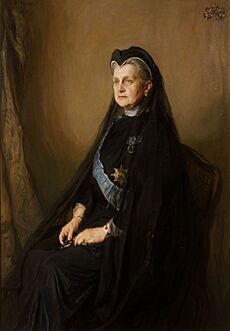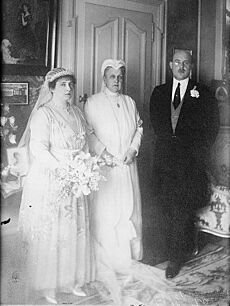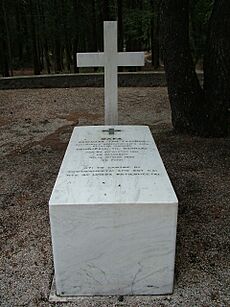Olga Constantinovna of Russia facts for kids
Quick facts for kids Olga Constantinovna of Russia |
|
|---|---|
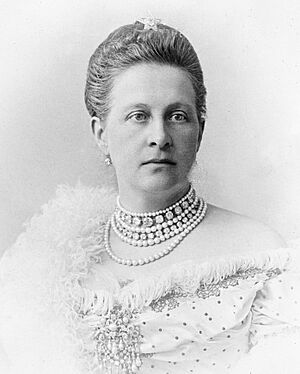 |
|
| Queen consort of the Hellenes | |
| Tenure | 27 October 1867 – 18 March 1913 |
| Regent of Greece | |
| Regency | 17 November 1920 – 19 December 1920 |
| Born | 3 September 1851 Pavlovsk Palace, Pavlovsk, Saint Petersburg, Russian Empire |
| Died | 18 June 1926 (aged 74) Rome, Italy, or Pau, France |
| Burial | 17 November 1936 Royal Cemetery, Tatoi Palace, Greece |
| Spouse |
George I of Greece
(m. 1867; died 1913) |
| Issue |
|
| House | Holstein-Gottorp-Romanov |
| Father | Grand Duke Constantine Nikolaevich of Russia |
| Mother | Princess Alexandra of Saxe-Altenburg |
| Signature |  |
Olga Constantinovna of Russia (Greek: Όλγα; 3 September 1851 – 18 June 1926) was the Queen of Greece. She was married to King George I. She also briefly served as the regent of Greece in 1920.
Olga was a member of the Romanov dynasty, a famous Russian royal family. She was the oldest daughter of Grand Duke Constantine Nikolaievich and Princess Alexandra of Saxe-Altenburg. She grew up in Russia and married King George I in 1867 when she was sixteen. At first, she found it hard to adjust to life in Greece. However, she quickly became involved in helping people. She started hospitals and schools.
After her husband was killed in 1913, Olga went back to Russia. When World War I started, she helped by setting up a hospital. She was stuck in her palace during the Russian Revolution of 1917. Later, the Danish embassy helped her escape to Switzerland. She could not return to Greece right away because her oldest son, King Constantine I of Greece, had been removed from the throne.
In October 1920, Olga returned to Athens because her grandson, King Alexander of Greece, was very ill. After he died, she became regent for a short time. This was until her son Constantine I returned to the throne. Later, the Greek royal family was sent away again. Olga spent her last years living in the United Kingdom, France, and Italy.
Contents
Early Life and Family
Olga was born at Pavlovsk Palace near Saint Petersburg, Russia, on 3 September 1851. She was the second child and first daughter of Grand Duke Constantine Nikolaievich. Her mother was Grand Duchess Alexandra. Olga's father was the brother of Tsar Alexander II. This made her a first cousin to Tsar Alexander III.
She spent her childhood at her father's homes, including Pavlovsk Palace. She also stayed at estates in the Crimea. Olga was very close to her older brother, Nicholas. She was one of the few family members who stayed in touch with him after he was sent away.
As a child, Olga was described as simple and a bit shy. She had a calm personality. She sometimes cried and ran from the classroom when her teachers asked her questions. In 1862, her father became the viceroy of Russian Poland. The family moved to Warsaw. Their time in Poland was difficult due to political unrest. These experiences affected Olga deeply.
Engagement and Royal Wedding
The young King George I of Greece visited Russia in 1863. He wanted to thank Olga's uncle, Tsar Alexander II, for his support. During this visit, George met Olga for the first time. She was twelve years old.
George visited Russia again in 1867. He was looking for a wife. He liked the idea of marrying a Russian grand duchess. This was because she would be from the Eastern Orthodox Church, like the Greeks. Olga fell in love with George. However, she was worried about leaving Russia. Her father thought she was too young at fifteen. He was also concerned about the distance between Greece and Russia. Her mother was more excited about the marriage. They decided Olga and George would marry after her sixteenth birthday.
Olga and George were married at the Winter Palace in Saint Petersburg on 27 October 1867. After five days of celebrations, they had a short honeymoon. Over the next twenty years, they had eight children:
- Constantine (born 1868), who became king after his father.
- George (born 1869).
- Alexandra (born 1870).
- Nicholas (born 1872).
- Marie (born 1876).
- Olga (born and died 1880).
- Andrew (born 1882), father of Prince Philip, Duke of Edinburgh.
- Christopher (born 1888).
The Tsar told Olga to love her new country very much. But she was not ready for her new life. When she arrived in Piraeus, Greece, she wore blue and white, the Greek national colors. The crowds were very excited. Olga was not used to such big crowds and almost cried. She could not speak Greek. She had to attend many official events. A few days after arriving, she was found crying under a staircase, holding her teddy bear. She quickly learned Greek and English. Her mother advised her to learn about Greek history and archaeology. This helped her gain public support.
Royal Life in Greece
King George I and Queen Olga were a loving couple. They spent a lot of time with their children. Their family life was warm and close. In private, Olga and George spoke German. With their children, they mostly spoke English. The children were expected to speak Greek among themselves.
The royal family's life was quite peaceful. The court in Athens was not as grand as the one in Saint Petersburg. They spent time at the Royal Palace in Athens and Tatoi Palace. In the summers, they vacationed in France or visited relatives in Russia and Denmark.
Olga always missed Russia. Her room had many icons from her homeland. She sang Russian hymns in the palace chapel. She often visited Russian ships in Piraeus. She was the only woman in history to be an Admiral of the Imperial Russian Navy. A Greek ship was even named after her.
Helping Others: Social Work
Olga was very popular and dedicated to charity work. When she arrived in Athens, she immediately supported the Amalieion orphanage. She also helped the Arsakeion school for girls. With her own money and help from others, she built homes for the sick and elderly. She also built a hospital for people with tuberculosis.
She started a group to help the poor. She opened a kindergarten for poor children. She also created a soup kitchen in Piraeus that taught cooking skills to poor girls. This later grew into a weaving school. Olga supported two military hospitals. She also helped fund the Evangelismos Hospital, which is Greece's largest. She built the Russian Hospital in Piraeus to honor her daughter, Alexandra, who had died. This hospital helped all sailors visiting Greece. Olga also helped establish hospitals during wars, like the Greco-Turkish War of 1897. For their work helping the wounded, Olga and her daughter-in-law, Crown Princess Sophia, received an award from Queen Victoria in 1897.
Before Olga, there were no separate prisons for women or young people in Greece. She helped set up a women's prison in Athens. She also helped create a prison for young offenders. In 1898, shots were fired at her husband and daughter. Despite this, Olga insisted on continuing her public work without extra guards. She was not very interested in politics.
Becoming a Widow
In 1913, the First Balkan War ended. The Ottoman Empire was defeated by Greece and its allies. Greece grew much larger. King George I moved to Thessaloniki to show Greek control of the city. On 18 March 1913, while walking, he was shot and killed. Olga said his death was "God's will." She arrived in Thessaloniki the next day. She and her family took the king's body back to Athens. He was buried at Tatoi Palace.
Olga's oldest son, Constantine, became the new king. His wife, Sophia of Prussia, became the new queen. Olga, now the queen dowager, returned to her home country, Russia. She stayed at Pavlovsk Palace, where she was born.
During World War I
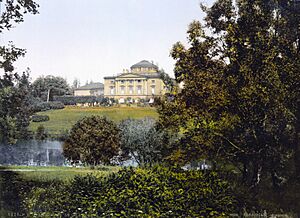
In August 1914, Olga was in Russia when World War I began. She decided to stay in Saint Petersburg. She set up a military hospital at Pavlovsk Palace. She helped care for wounded soldiers with her sister-in-law. Other royal family members also helped at the front lines. As the war continued, Olga saw that Russia was facing big problems. She tried to warn the Tsarina about the danger of a revolution.
Meanwhile, her son, King Constantine I of Greece, wanted Greece to stay neutral in the war. His wife was the sister of the German Kaiser. This caused problems between him and the Greek Prime Minister. The Prime Minister wanted Greece to join the Allies. This led to a big disagreement in Greece.
In February 1917, the Tsar's government in Russia fell apart. Olga's sister-in-law left Pavlovsk, but Olga stayed. She was almost alone, with only one young helper. They had little food. After the October Revolution, soldiers invaded and searched the palace. Olga was not hurt. She knew she had to leave Russia. But the new government would not let her go. In Greece, her son Constantine had been removed from the throne. His second son, Alexander, became king instead.
Life in Exile
After many months, the Danish embassy helped Olga get a passport. She traveled through Germany and joined her son Constantine and his family in Switzerland in early 1919. Other members of her Russian family were not so lucky.
In Switzerland, Constantine I and his family had little money. The Greek government did not pay pensions to former rulers. They also stopped contact between the exiles and King Alexander. Olga had lost her property in Russia. She had to live a simpler life. However, she enjoyed spending more time with her children and grandchildren.
A Short Time as Regent
On 2 October 1920, King Alexander was bitten by a monkey. The wound became infected, and he became very ill. He called for his mother, but the Greek government would not let her return. Queen Sophia asked Olga to go to Athens to care for Alexander. After some talks, Olga was allowed to return to Greece. But she arrived twelve hours after her grandson died on 25 October. Olga was the only royal family member at his funeral.
The government did not want Constantine I or his older son, George, to return to the throne. They offered the throne to Constantine's third son, Prince Paul. But he refused. Days after Alexander's death, the Prime Minister lost an election. On 17 November, the regent stepped down. The new prime minister asked Olga to become regent. She served for about a month. Her son Constantine returned to the throne on 19 December after a public vote.
Second Exile and Final Years
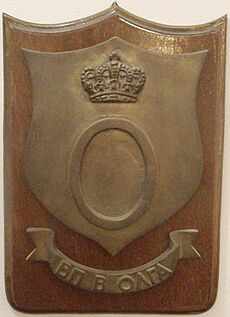
Constantine I returned to the throne during the Greco-Turkish War. In September 1921, Greece suffered a big defeat. Constantine's policies during World War I meant Greece did not get much help from other countries. The new leader of Turkey, Mustafa Kemal Atatürk, took back land from Greece.
After a military coup on 27 September 1922, Constantine I gave up his throne again. He went into exile in Italy with Olga and other family members. His oldest son, George II, became king for a few months. Constantine died in Italy soon after. Olga's son, Prince Andrew, was arrested. Many people were executed after the coup. Other countries helped save Prince Andrew. He was sent away for life. His family, including baby Prince Philip, Duke of Edinburgh, also went into exile.
Olga received a pension from the new Greek government. But she kept many old servants who had fled Greece with her. This left her with little money for herself. However, her family across Europe supported her. In the United Kingdom, she stayed with her youngest son, her daughter, and her nephew, King George V.
Olga's last years were marked by poor health. She used a wheelchair because she had trouble walking. She went to Paris several times for eye treatment. Olga eventually settled with her youngest son, Prince Christopher. She died on 18 June 1926. She passed away either in Rome, Italy, or Pau, France.
Even though Greece was a republic, Olga was still respected. The Greek government offered to pay for her funeral and bring her body back to Greece. But her children chose to bury her in Italy next to her son, Constantine I. Her funeral was held on 22 June 1926 in Rome. The next day, she was buried in Florence. After the Greek monarchy was restored in 1935, she was re-buried in Tatoi on 17 November 1936.
Much of her property had been taken by the Soviet Union and the Greek government. Her estate mostly included jewelry, valued at about £100,000. This was shared among her children and Constantine I's children. Olga was deeply affected by the Russian Revolution. She wanted to cut all ties with Russia. Before she died, she made her grandson, King George II, promise to bring her daughter Alexandra's body back to Greece. This wish was fulfilled in 1940.
Images for kids


